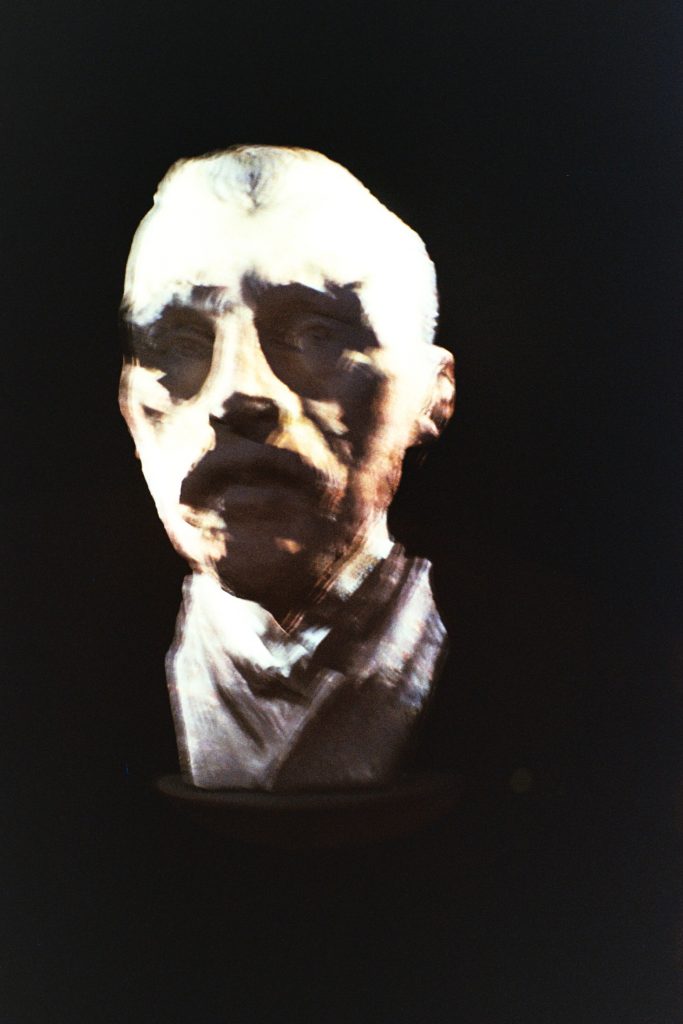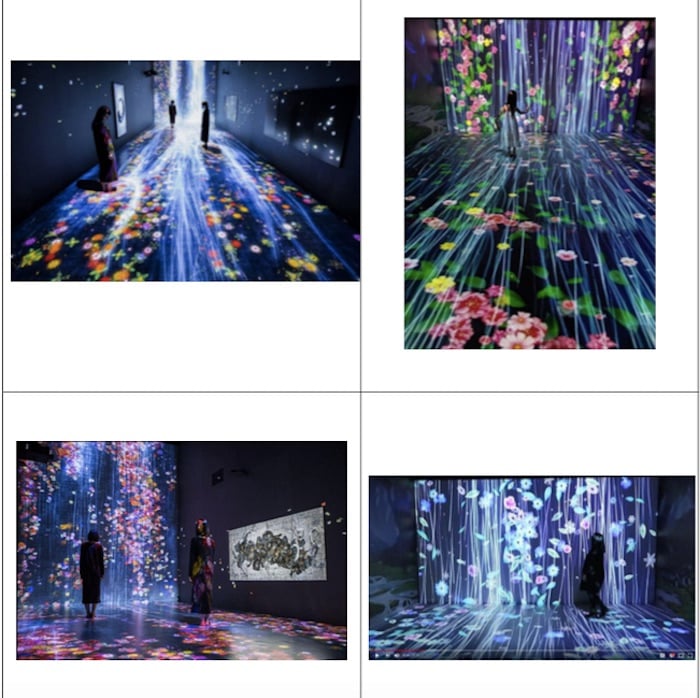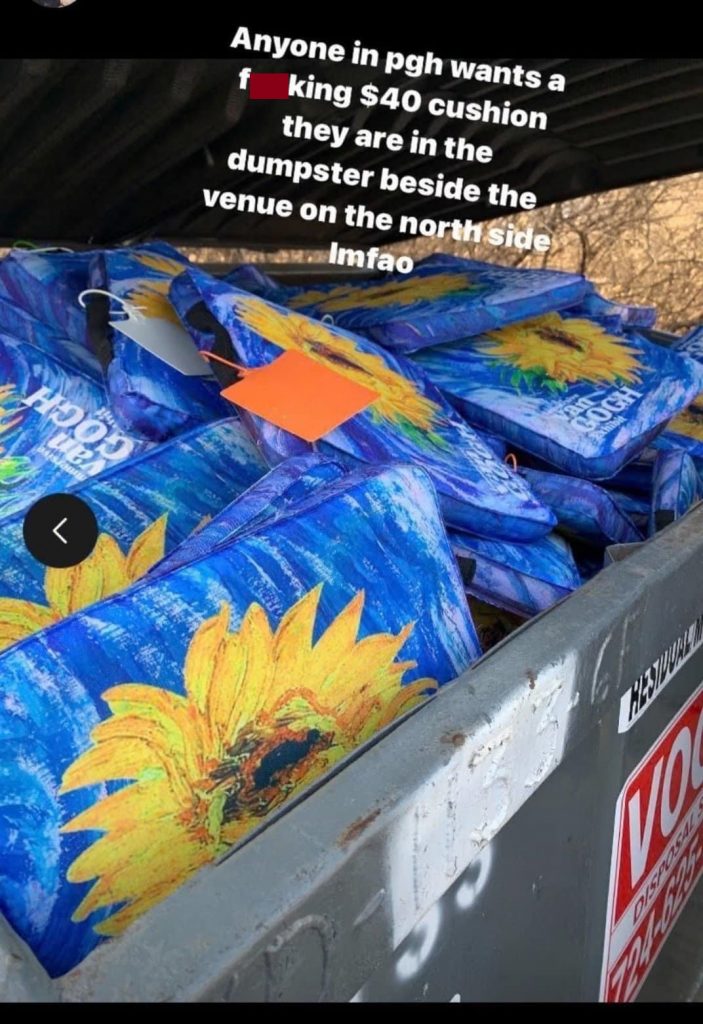
Immersive art experiences are dominating the current cultural landscape, and rapidly evolving to accommodate audiences who are no longer as engaged with conventional presentations of fine art. Prior to the COVID-19 pandemic experiences like Sleep no More and Meow Wolf were considered the cutting edge of artistic presentation, and while both are still extremely popular and commercially viable, a new wave of immersive art experiences has permeated major cities across the country.
Projection-based immersive art experiences have surged in popularity both in the United States and abroad in recent years. They draw major audiences, even while museum attendance still fighting to return to pre-pandemic numbers. These are works that forgo conventional museum settings for warehouses and other commercial spaces that can accommodate the necessary hardware and projectable surfaces required for these events. Visually dynamic, and aesthetically maximalist, these exhibitions are designed to captivate an audience that has spent the past several decades bombarded with digital stimulation. They transform 2-dimensional art into lush environments and are designed to both be enjoyed in person and to be shared over social media.

It is impossible not to examine this phenomenon without immediately encountering some fashion of immersive Van Gogh exhibit, which will act as the point of examination for much of this article. There are currently 50 immersive Van Gogh exhibitions happening in the United States, being produced by at least five different production companies. Each one is named with some amalgamation of the words Van Gogh, experience, immersive, beyond, alive, and original. Widely posted on social media, featured on an award-winning Netflix show, and prominently advertised on busses and billboards in major cities, Van Gogh’s popularity is reaching heights never imagined.
But why Van Gogh?
From a utilitarian perspective, it is simply far easier to display the works of Van Gogh, or any other great master, by projecting its likeness rather than by acquiring the actual work. While Van Gogh was a prolific artist, creating over 900 paintings during his short career, it is incredibly difficult for even the most well-regarded institutions to acquire one for display. His paintings are fragile, expensive, and costly to insure. They require special considerations for handling and display and can be targeted for theft. It takes a tremendous amount of work to get even a single Van Gogh painting on a wall, and once you do it can be a massive liability for your institution.
From an aesthetic perspective, his work is incredibly recognizable even to those with only a cursory appreciation of his style. Even someone with a passing familiarity with Van Gogh will quickly be able to identify his stylistic tendencies, and this recognition can be amplified when animated and reconfigured onto 3-dimensional objects
From a grimly practical standpoint, he is a very easy artist to work with because he is dead. 100 years after his death, all his works entered the public domain. If you wish to start your very own original immersive Van Gogh Experience, you do not have to seek permission from the artist, court his endorsement, or hold yourself to his presentational standards. You just need a space with plain white walls, a team of technicians to develop the show, and enough money to pay for the endeavor until the audience starts showing up.
But what do we lose when an artist like Van Gogh has their work transformed to be presented in this radically different medium?
When we look at a projected image, or even a high-quality printout, of Van Gogh’s work we can easily lose an appreciation of his technique. Van Gogh is known for an aggressive application of paint, often applied straight from the tube, or spread with a pallet knife in lieu of a brush, which imbued his works with remarkable textural quality. One cannot appreciate the techniques that were utilized to create these works when they are flattened and expanded onto a projectable surface. These exhibitions also deprive their audiences of time spent with individual works. When presented in a rapid fashion, audiences are not permitted to take their own time in examining the works, compare them to others that may be present, or discover intricacies within the carefully composed images.
Many of the most popular immersive works on display in the United States have no discernible connection to the artists whose work they represent. Immersive Frida Kahlo an exhibition based on the life and work of the acclaimed Mexican painter, only barely acknowledges that they are not affiliated, sponsored, or endorsed by the Frida Kahlo Corporation. Banksy, whose work has nerve been copyrighted has had several immersive shows produced without his consent. The Art of Banksy: Without Limits, a show that has been touring internationally since 2016, drew the ire of audiences when it became apparent that they had misrepresented the number of original works being displayed at the exhibition. Fever, a ticketing agency specializing in immersive shows ended up issuing refunds, albeit to a little less than 1% of their European ticket buyers, and less than 1.5% of their Asian ticket buyers. Banksy has openly stated that his work is currently being presented without his consent for numerous commercial endeavors, but there can be little recourse for artists in these positions.
It is important to note that this medium is not exclusively occupied by production companies who are taking advantage of the artwork in the public domain. Plenty of contemporary artists and collectives are embracing the medium and developing original works that are driven by artistic intention and fully embrace the possibilities of immersive spaces.
TeamLab is an international collective of artists who have presented immersive experiences all over the world. They successfully utilize the immersive medium to transcend conventional art, by creating works that move throughout physical space, interact with one another, and are designed by the artists themselves to create objective-driven experiences for their audiences. Their works have been shown throughout museums in the United States, Europe, and Asia, both in Museum and Gallery settings.
Jen Stark is a multimedia artist who has embraced immersive presentation of her work to great success. Throughout their career, they utilized materials such as paper, wood, metal, and paint to create organic, molecular cloud-like structures radiate with vivid colors and echoing patterns. She has done artistic collaborations with Apple, Google, Vans, MTV, and Smashbox. Recently, Stark has begun using digital mediums, creating a series of hypnotic NFTs and interactive digital projections. In 2021 Stark debuted Cascade: a Jen Stark Experience at The William Vale, a luxury hotel in Williamsburg Brooklyn. The exhibition featured 6,000 square feet of interactive projections, paintings, sculptures, and 3-D Mapped environments. Stark seems to stand-out among contemporary artists whose unique vision and individual works have seamlessly transitioned into the immersive space.
It will be a long while before most emerging artists are able to follow the lead of Jen Stark or teamLab. Development and implementation of these works are cost-prohibitive and usually require a major collective of artists and developers as well as the support of external production companies or corporations acting in roles traditionally held by patrons of the arts. While industry front runners are advancing the technology to streamline the process of creating an immersive experience, there is little incentive for them to make their proprietary software available to other artists or collectives. As this field advances, artists and collectives are likely to remain fiercely protective of their intellectual property.
TeamLab has even gone so far as to file a lawsuit against the Museum of Dream Space for copyright violation with the presumed intention of misleading audiences into thinking the two parties collaborated on an exhibition. The suit claimed the Museum of Dream Space showcased works with notable similarities with teamLabs previous works Boundaries (2017) and Crystal (2015).

TaeamLabs suit argues that the Museum of Dream Spaces exhibits appropriate their own copyright by utilizing
“the use of multicolored flowers flowing across the ground, the streams of light/water cascading down the wall and onto the ground, and the interactivity of the work responding to the user’s proximity to the exhibit. Both works contain artwork flanking either side of a waterfall giving off the appearance of outer space or stars.”
While visual comparisons of the two exhibits show undeniable similarities, the wording of the suit is cause for concern. By attempting to enforce a copyright on such elemental aspects of artistic expression there is a huge risk for future suits against artists attempting to enter the field. While the suit between teamLab and the Museum of Dream Space could still be settled out of court if there is a ruling it could lay out the groundwork for targeted copyright enforcement among competing arts enterprises. A hearing for this case will be held on June 10, 2022, and if no judgment is made and the parties decline to settle, the case is slated to go to trial in August.
So while the field of immersive art experiences is crowded and fiercely competitive, the question remains how much longer can it last at its current pace. It is safe to say that projection-driven immersive art spaces are here to stay, but we will inevitably stop seeing nearly as many presentations of the deceased masters within these spaces. There is not nearly enough recognizable work in the public domain to keep up with the demand for much longer, and inevitably museums will begin to adopt this means of presentation to enhance the display of works they already have in their possession. Eventually, the hardware and software necessary for implementing these endeavors will become cheaper and more accessible, both to average consumers and arts institutions. As the initial gimmick of immersive spaces begins to lose its efficacy, audiences will place more value on innovation within the field which will create more room for artists who are eager to develop work specifically for immersive spaces. The commercially driven enterprises with little interest in the art itself will move on to the next big thing cash grab, and the remnants of their gift shops will likely end up in a landfill.
If you think that’s cynical, maybe check the dumpster behind your local Immersive Van Gogh Experience.

Bibliography
“8 Tech Innovations Becoming Standard in Museums and Heritage Sites.” Museums + Heritage Advisor. Accessed April 22, 2022. https://advisor.museumsandheritage.com/features/8-new-technologies-becoming-standard-museums-heritage-sites/.
“About Us.” Exhibition Hub – World Class Exhibitions, September 28, 2021. https://www.exhibitionhub.com/about-us/.
“About.” Jen Stark. Jen Stark. Accessed May 4, 2022. https://www.jenstark.com/about.
Artnet News. “A Guide to the Immersive Van Gogh Experiences in the U.S.” Artnet News. Artnet News, August 24, 2021. https://news.artnet.com/art-world/immersive-van-gogh-guide-1974038.
Bishara, Hakim. “‘Open for Exploitation’: Artists Project Messages on Guggenheim Museum Ahead of Reopening.” Hyperallergic, November 5, 2020. https://hyperallergic.com/590869/guggenheim-museum-projections/.
Boucher, Brian. “’Emily in Paris’ Fueled a Frenzy for Immersive Van Gogh ‘Experiences.’ Now a Consumer Watchdog Is Issuing a Warning about NYC’s Dueling Shows.” Artnet News. Artnet News, March 16, 2021. https://news.artnet.com/art-world/immersive-van-gogh-better-business-bureau-1951887.
Cascone, Sarah. “Organizers of an Unauthorized Banksy Show Will Issue Refunds after Visitors Complain There Aren’t Enough Real Banksys in It.” Artnet News. Artnet News, September 6, 2021. https://news.artnet.com/art-world/seoul-banksy-show-complaint-fake-art-2002916.
Davis, Ben. “Two Immersive Van Gogh Experiences Offer the Post-Pandemic Escapism Visitors Crave. but They Have Nothing to Do with Van Gogh.” Artnet News. Artnet News, June 25, 2021. https://news.artnet.com/art-world/immersive-van-gogh-experiences-1983011.
“Home.” Immersive Frida, February 11, 2022. https://www.immersive-frida.com/.
“Home.” Immersive Van Gogh. Immersive Van Gogh, April 7, 2022. https://www.immersivevangogh.com/.
“Home: The Art of Banksy without Limits.” Theartofbanksy. Accessed May 4, 2022. https://www.theartofbanksy.com/.
Kinsella, Eileen. “TeamLab Is Suing a Los Angeles Museum for Allegedly Copying Its Instagram-Friendly Light Installations for Its Own Display.” Artnet News. Artnet News, April 29, 2022. https://news.artnet.com/art-world/teamlab-museum-of-dream-space-lawsuit-2105207.
Kleiman, Joe. “Barco: The ‘Invisible’ Projector.” InPark Magazine, April 13, 2022. https://www.inparkmagazine.com/barco-the-invisible-projector/.
“TeamLab.” teamLab. TeamLab. Accessed May 4, 2022. https://www.teamlab.art/.
“Van Gogh Exhibit Pittsburgh: The Immersive Experience.” Immersive Van Gogh Pittsburgh, December 7, 2021. https://www.vangoghpittsburgh.com/#.
Vassigh, Alidad. “How Digital Technology Is Revolutionizing Art Exhibitions.” Worldcrunch. Worldcrunch, March 1, 2022. https://worldcrunch.com/tech-science/immersive-van-gogh-art-exhibition.